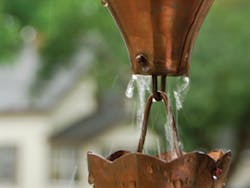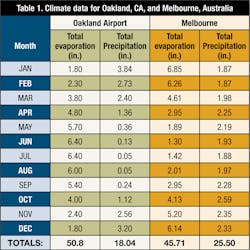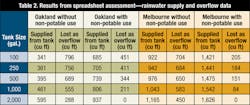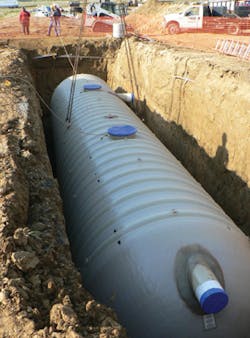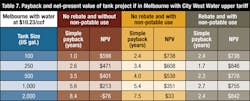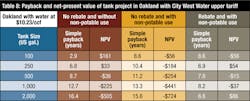Growing up in Birmingham, England, it was common place for every home gardener to have a 25- to 50-gallon rainwater barrel attached to a convenient downspout in the front and back of the house, to the garage if located at the rear of the garden, and/or to the greenhouse. Gardeners would then supplement summer rainfall on vegetable and flowerbeds and/or water the interior of the greenhouse using a watering can filled from the rain barrel. I remember my father extolling the virtues of rainwater over tap water for growing good tomatoes and lettuces and decrying the waste of letting all that good rain go down the drain. It wasn’t that this saved us any money–back then our water bill was a fixed flat rate, not a variable metered volume charge–rather it was a common-sense approach that fitted into a general ethos of frugality and efficiency that characterized his, and earlier, generations.
Later on, as a junior consultant in soil and water conservation, I found myself assessing rainwater harvesting activities in rural development projects across Africa, documenting, for UNICEF and others, the various applications of rainwater harvesting technologies for the purpose of providing onsite sources of potable water in areas where public systems were absent, and where indigenous, communal water sources such as shallow groundwater were inadequate as safe drinking supplies. On one assignment, I lived for several months in a thatched-roof traditional dwelling, supplied solely with runoff captured from an adjacent rock outcrop and stored in a reinforced concrete tank hand-built next to the house by local craftsmen trained by the Danish international development agency I was working for. Previously, as a graduate student, I had researched surface runoff harvesting systems in the Negev Desert of Israel, where ancient civilizations depended for their year-round supply on runoff water stored in excavated cisterns that drained from rocky hillsides and developed terraced agricultural systems supported by flood irrigation captured from distant hillsides using a network of carefully planned diversion ditches. Thousands of people were supported this way in an area where annual rainfall typically totaled around 90–100 millimeters (4 inches), often with six to eight months of the year with no rainfall whatsoever.
A major impetus for this paper was that I recently began a private garden remodeling project in Oakland, CA, offering a return to my frugal roots and to the footsteps of my father because I have the opportunity to design and install a rainwater catchment system to make use of a conveniently located, 900-square-foot section of roof area with downspouts that can be configured to supply a storage tank located next to the house. The tank would be at an elevation that would permit simple gravity flow of water to the terraced ornamental and vegetable garden areas below through drip or soaker hose. (Local regulations do not currently permit residential irrigation systems to irrigate untreated stored rainwater or graywater through sprinkler application.)
My decision to consider this project clearly goes back to my English roots, but more directly dates back to a month I spent working with the Department of Sustainability and Environment of the State of Victoria, Australia, assisting its staff in their implementation of a 50-year planning framework for water management. Faced with prospects of intense droughts and potential long-term supply reductions from existing catchment and reservoir systems and a growing population, Victoria–in line with the Australian government–has adopted an aggressive, innovative, and holistic approach to water planning and management.
Household rainwater tank installation in suburban Australia
Laid out in the 2004 blueprint Our Water, Our Future, the government of Victoria is promoting a wide variety of water efficiency and other measures that take the notion of integrated water resources planning to a level not yet found across the United States (Government of Victoria 2004). One of the technologies being promoted in Victoria, both for existing and new construction, is domestic rainwater harvesting. Since the days of the early settlers, it has been common across Australia for rural households not connected to a municipal water distribution system to use rooftops and rainwater storage tanks to provide domestic supplies. However, it is becoming increasingly common to find rainwater tanks being employed as part of water conservation measures in urban centers, for both homes and businesses, substituting for existing supplies where retrofitted to buildings, and reducing incremental system demands where installed on new construction.
Rainwater is being promoted not only for landscape irrigation, but also through integration to the internal plumbing of the building for flushing toilets and washing clothes. Less complicated and problematic than graywater systems (i.e., the reuse of wastewater from sinks, showers, and clothes washers), rainwater harvesting is promoted as a means of creating a hybrid potable/non-potable supply system for domestic water uses without having to develop a municipal dual-plumbing system for a complete community or treat domestic graywater to deal with human pathogens or chemicals introduced to it prior to its collection. Rooftops provide the source of water, onsite tanks provide the storage, and a limited modification of internal plumbing provides the distribution. For existing buildings, this usually requires the strategic location of a rainwater tank on an exterior wall adjacent to a bathroom or laundry room and a direct connection through the wall to the toilet tank or the washing machine located inside. A simple manual control valve can allow users to switch between the rainwater supply and the regular potable supply for each device, or alternately, the rainwater tank could be filled during a rainless period from the potable supply to save the need to switch sources.
According to the Government of Victoria Web site, some 38,000 rebates have already been issued for the installation of rainwater harvesting systems as part of the Water Smart Gardens and Homes program (Government of Victoria 2010a). As of June 2010, a rebate of AUS $150 (approximately US $125) was being offered to homeowners for installation of a tank of 600–1,999 liters (approximately 160–540 US gallons), along with an additional AUS $150 for a toilet connection. For larger tanks connected to a toilet and/or laundry, rebates are higher, ranging from AUS $500 (approximately US $425) for a 2,000- to 3,999-liter (approximately 540–1,080 US gallons) tank to AUS $1,000 (approximately US $850) for a 4,000-liter (approximately 1,080 gallons)-or-greater-sized tank (Government of Victoria 2010b). Tank design and installation must comply with Australian standards and guidelines. This program is an enhanced version of the rebate scheme offered as part of the Australian government’s $12.9-billion Water for the Future plan, which has a National Rainwater and Greywater Initiative to help people use water more efficiently and wisely (Government of Australia 2010a). All Australians meeting the requirements have had the opportunity since January 30, 2009 and through March 31, 2014 to receive a grant of up to AUS $500 (approximately US $425) towards the purchase and installation of a rainwater tank of 2,000-liter (approximately 540 US gallons) capacity or greater for existing buildings. This program does not cover new construction since, in many Australian jurisdictions, integrated rainwater harvesting systems are now mandated by building codes as part of design requirements (Government of Australia 2010a).
Peaking Interest A perusal of the literature and a survey of world civilizations show that rainwater harvesting has been used extensively as a low-tech solution to human water needs for millennia. My own relationship to rainwater harvesting has been a long and varied one, although I admit to giving it little thought over the last decade or so as I switched my professional attention to the issues of urban water management in the United States and global metropolises, and away from the day-to-day issues affecting developing nations where I began my career. However, with our fears of global warming effects on climate, a growing urban population, and a broader movement to promote sustainable development, I have begun to turn my attention back to the humble topic of using onsite generation and storage of rainwater as a water supply and efficiency measure.Increasingly, I have noted in my studies that rainwater harvesting is beginning to appear as a serious option for consideration as a potential supplementary water source and conservation measure for new and existing constructions, even here in the San Francisco Bay Area where I am based (SFPUC 2010a), and is being integrated across the United States into green building guidelines and codes such as the US Green Building Council’s LEED program. Installation of rainwater harvesting currently accounts for one point in the LEED-new-construction scoring system and potentially could help the building qualify for other points through achieving above-code water savings, stormwater reduction, reduction in sewage discharge generation, and achievement of water efficient irrigation (USGBC 2010). State plumbing codes around the nation are slowly being modified to permit the installation of rainwater harvesting systems for use as part of irrigation systems and/or non-potable water supplies for selected interior water use (often classified as graywater systems, although I believe a clearer distinction should be made between graywater and rainwater). A recent example is the 2009 amendments to the 2006 Georgia plumbing code that pertains to rainwater recycling systems (State of Georgia 2009).As an academic, as well as a home gardener interested in the practical application of water conservation technologies like rainwater harvesting, I have looked at this backyard rainwater project as both a planning and a research exercise. In my classes on water management and sustainability, I find myself frequently pointing out to my students that one of the reasons we are so wasteful of our water in the United States is because, in many locations—especially California—we a) have historically had abundant supplies relative to demands, and, consequently, b) have priced water much lower than its actual and future costs (in part, due to our failure to recognize external costs that have resulted from system development—for example, in California, the impacts on the San Francisco Bay-Delta and the salmon industry, among other factors).In other parts of the world, where a) supplies have been more limited, and/or b) authorities have been more forward-looking, and/or c) the need for conservation and the future costs of failing to do so are both higher and more imminent, water is far more expensive and government assistance to consumers wishing to partner in substantive conservation are more readily available—for example, in Victoria, Australia. So I decided not only to evaluate the financial viability of a potential rainwater harvesting system for this backyard in Oakland, but to model how its performance and cost-effectiveness would differ if it were to be installed in a climatically and institutionally different setting, specifically Melbourne, where such water harvesting systems, so rare to date in my water provider’s service territory, are already commonplace.Through a relatively simple analysis, I have sought both to satisfy my curiosity and provide myself with greater insight, as someone interested in water resources sustainability and how we might achieve it, into how a) the climatic regimen (i.e., monthly distribution of rainfall) and irrigation requirement seasonality, b) the addition of domestic non-potable water use, and c) tank sizing might affect the performance and hence the cost-effectiveness of a potential system in two different locations and for two distinct tariff and rebate scenarios. As a postscript, if I do decide to go ahead with my rainwater harvesting project, I need to remember one more thing from my childhood home. One of the drawbacks of those rustic rain barrels my family used was that they weren’t very sophisticated and didn’t have a first-flush system that diverts the initial runoff following a rainless period. Thus, the runoff water periodically included washed-off organic material (leaf litter), and it frequently looked and smelled awful. Similarly, they were not effectively sealed to the outside environment, allowing both sunlight and insects to enter. If I were allowed to install such a poorly designed rainwater system in Oakland, it would clearly represent a potential health and nuisance hazard, in particular, due to its ability to become a breeding environment for potential disease vectors—for example in California of the West Nile Virus and Canine Heartworm parasite among other pathogens. Several breeds of mosquitoes, particularly of the genus Aedes and Culex, like to breed in the clear freshwater stored in rainwater tanks and even a small access hole the size of a pencil will be sufficient to permit ingress of adults and the egress of hatched larvae. Other types of mosquito can also be attracted to rainwater systems if the stored water contains leaf debris and algal growth. This is a major concern to our public agencies and is one of the main reasons why rainwater harvesting systems are regulated and must be designed and installed using approved methods and standards, and be adequately maintained by homeowners once in place. My design will need to have both an effective first-flush and a sealed containment system that excludes all insects. After all, the last thing I want to do after completing my project is to set on the deck and swat mosquitoes all evening!
System Assessment
In order to assess a rainwater harvesting system, three basic pieces of information are required. The sophistication with which this information is used depends on the data quality available and the assumptions and mathematical procedures incorporated into the analytical instrument (e.g., monthly or daily accounting of runoff and demand). They are size and type of catchment area, rainfall quantity (at least monthly, ideally daily), and volumetric demand (at least monthly, ideally daily). Volumetric demand can be estimated (e.g., by using evapotranspiration data and square footage of different irrigated vegetation, estimates of toilet flushing frequency, etc.) or based on actual historical consumption.
There are a number of performance calculators available in the public domain for assessing water harvesting performance. Two of the more impressive include that developed by the San Francisco Public Utilities Commission (SFPUC), specifically to size rainwater tanks for irrigation and non-potable use in the City of San Francisco (SFPUC 2010b), and that developed by the University of Warwick, UK, to size rainwater tanks for domestic use (potable and/or non-potable) anywhere in the world, for which rainfall data is available (University of Warwick 2010). Both use monthly rainfall and demand totals.
For this paper, however, I have used my own spreadsheet tool for water tank performance assessment, the prototype of which I developed 25 years ago when I was still a graduate student, and which I recently dusted off and modified for use with my garden project. Like the others, the tool has some complicated algorithms, but is basically a simple mass-balance calculation that takes a set of monthly precipitation data, inputs a rooftop catchment area and an assumed runoff coefficient (to allow for evaporation, retention, first-flush, and so forth–it seems pretty standard to assume 0.85 for rooftops), and produces a monthly runoff total. (Note that, in doing so, as with most monthly calculators, it necessarily assumes that the rainfall is distributed evenly across the month. However, we know that this is not the case, and a more sophisticated model would make the calculation at a higher resolution of a daily scale, either using actual daily rainfall records or some stochastic procedure that used magnitude and frequency data to simulate the spacing of rainy and rain-free days that typically result in a given month’s average total. It is expected that a daily model would predict lower yields and greater overflows for smaller tanks compared to larger tanks).
It also uses actual or potential evapotranspiration data (or pan evaporation data as a less accurate means to determine water needs), along with a coefficient for a particular vegetation type if needed and the total irrigated area to estimate the monthly irrigation demand to be supplied, if available, with stored water in the tank over the course of each month. (Note that, as with rainfall, it is not necessarily the case that irrigation takes place equally on every day of a given month, and a more sophisticated model might incorporate a more disaggregated approach based on an assumed or actual watering regimen.) In addition, the tool provides the option of adding an average daily non-potable water demand for toilet flushing, clothes washing, and so forth as desired, calculated as a monthly total, if it is planned to also use the rainwater harvesting system to meet interior or exterior non-irrigation needs currently met from the potable water supply. Note that non-potable use is assumed, for the purpose of this analysis, to be a constant 77 cubic feet per month. This is calculated assuming that one ultra-low flow toilet (1.6 gallons per flush) is connected to the rainwater tank and it is flushed daily four times each by three residents, a total of 12 flushes and 19.2 gallons per day, 576 gallons per month.
So, briefly, what are the major bigger-picture advantages of rainwater harvesting in an urban environment that I (and the agencies that should support me and others with subsidies for implementing water harvesting to reflect the indirect economic advantages to society, as is the case in Australia), should take into account?1. It reduces reliance on finite municipal sources, especially important during times of drought, and it offsets the need for additional capital investments, which generally carry a much higher per unit cost than already developed, existing supplies.2. It substitutes rainwater for treated water, thus avoiding the embedded environmental costs and energy consumption of treatment and delivery associated with using potable supplies for non-potable purposes.3. It provides an emergency, onsite source of water in case of temporary, even prolonged interruption of municipal supplies, for example as the result of an earthquake (stored rainwater can relatively easily and cheaply be rendered potable through boiling, microfiltration, or chlorination).
4. It reduces the volume and peak flows of stormwater runoff, reducing the risk of both urban flooding and nonpoint source pollution. (Note that, interestingly, in some jurisdictions—for example in Berlin, Germany—residents are assessed a tax on their residential runoff and rainwater harvesting, which increases onsite infiltration and evaporative loss that would reduce these fees.)
On a final note, it is worth acknowledging that there are a number of common problems faced in retrofitting rainwater systems wherever they are located and assuming that local ordinances permit their use for interior non-potable purposes. They include:
1. Rooftop and gutter configurations of existing buildings may not permit harvesting into a single tank, requiring multiple tanks or only partial roof use.
2. Exterior landscape and rooftop and gutter juxtaposition of existing buildings may not permit gravity flow from storage location to use location, requiring pumping.
3. Potential interior uses may not be easily accessible to an exterior storage location and/or cannot be supplied by gravity flow, requiring elaborate and expensive structural modifications to plumbing and fixtures.
Note that if local laws do not allow sprinkler application of captured rainwater, it will prevent the effective use of this water for turfgrass irrigation, the major consumer of water in many urban residential landscapes. Of course, this will not be a concern in situations where xeriscape is used and turfgrass is absent since most shrubs and groundcover can be watered using non-sprinkler devices.
In the absence of a more detailed data set for Melbourne, Australia, mean monthly pan evaporation data was used for both Oakland and Melbourne to calculate the irrigation demand for the landscape area. For a more accurate assessment of the performance for a rainwater harvesting system that calculates monthly demand, actual evapotranspiration, for example, that’s supplied by the California Irrigation Management Information System (CIMIS), and an appropriate vegetation coefficient would need to be used. CIMIS data is available for the Oakland Foothills region where my rainwater harvesting project would be located, calibrated for residential (turfgrass) vegetation, and thus this could be used in an assessment of irrigation demand. However, similar evapotranspiration data was not available for the Melbourne urban area. Pan evaporation data will typically overestimate plant water demands, the degree to which it will do so varying from month to month depending on the time of year, and thus the amount of photosynthesis and evaporation taking place. However, any overestimate in irrigation demand in this analysis will compensate for the fact that irrigation efficiency has not been factored in to the calculation; the ability of the irrigation system to supply water that can actually be used by the vegetation can be anything from 0.75 to 0.95 for drip and soaker irrigation, meaning that actual water needs will be greater than calculated water needs using evapotranspiration data. The calculations used in this paper can thus be assumed to provide a general order of magnitude of the irrigation demand for a 1,000-square-feet garden area to be supplied in part by rainwater storage.
City West Water is one of the three major water utilities providing water to the City of Melbourne, Australia, the principal population center in the State of Victoria. It serves around 800,000 of the city’s more than three million residents. To promote water use efficiency, among other initiatives City West Water offers rebates on rainwater tanks (up to US $850), graywater systems (up to US $425), and dual-flush low-flow toilets (US $85) (City West Water 2010a). In Oakland, CA, water is provided by the East Bay Utility District (EBMUD) to around 1.2 million consumers. EBMUD does not currently offer rebates for domestic rainwater harvesting or graywater systems, but it does offer customer rebates on high-efficiency toilets (US $50) and clothes washers (US $100), on self-adjusting irrigation controllers (US $200), and for turfgrass replacement (up to US $500) (EBMUD 2010a). Both City West Water and EBMUD offer assistance with education, audits, showerheads, and water-saving garden products such asmulch, etc.
In addition to their contrasting programs with respect to rebates, it is informative to look at their residential water fee structures. Both utilities charge a combination of fixed service charges and variable commodity rates to customers. Of importance in determining the cost-effectiveness of a given water conservation and efficiency measure, of course, are the variable rates. Table 3 shows the relative pricing for water for City West Water and EBMUD residential customers and the effect of the inclining rate conservation-based tariff structure that both have adopted. At the highest tier, those high-volume water users who would benefit financially the most from an on-site source of water that could substitute for municipal supplies, a 100-cubic-foot (748 gallon) billing unit of water (ccf) costs $3.27 for EBMUD customers and $10.23 for City West Water customers (given that City West charges an additional $3.80 per billing unit as a volume-based fee for wastewater treatment). Note that these are the values I have used in my analysis–a lower-volume water user with smaller household consumption would need to use the lower tiers in a similar calculation. Clearly, water is a much more expensive commodity and represents a larger share of household expenditure for the residents of Melbourne, than it does for us in Oakland. It, thus, affects greatly the relative cost-effectiveness and, hence, attractiveness of water conservation and efficiency measures, all things being equal.
Dollars and Tanks
Water tank prices will vary based on design and so-forth. A perusal of various Web sites indicated that round polyethylene water tanks certified to Australian national standards for potable water storage cost around AUS $500 (US $425) for a 1,000-liter (264-US-gallon) tank, AUS $750 (US $637) for a 2,500-liter (660-US-gallon) tank, and AUS $1,000 (US $850) for a 5,000-liter (1,320-US-gallon) tank for the Melbourne area including taxes and delivery. This is broadly similar to costs in the US, where an assessment of tank prices at various internet suppliers indicate that tanks made from food grade safe Food and Drug Administration-approved, California-compliant polyethylene plastic, and suitable for potable water storage cost around US $100 for a 100-gallon tank, US $250 for a 250-gallon tank, US $350 for a 500-gallon tank, and US $800 for a 1,500-gallon tank exclusive of local sales taxes and delivery. What is not factored in is the cost of installation, which if a system is to be installed in an existing construction to include non-potable uses (requiring an element of dual-plumbing) to comply with official code regulations and through a permitting process will usually require a qualified plumber in addition to necessary materials such as valves, joints, piping, and so forth. For more straightforward irrigation-only installations, modifications will be more straightforward and could be completed by a homeowner. Thus, no installation costs have been added to this assessment, but likewise, no subsidy would be available without a non-potable connection given the terms of the Victoria program. Given that plumbers cost between $50–100 per hour in the Bay Area (it seems to be about half as much in Melbourne), it seems reasonable to assume that installation, which should take a day or so to attach the necessary pipes to toilets and so forth, might be around an added US $500 for labor and materials in Oakland and US $250 in Melbourne. However, these are probably underestimates.
The relative costs of water, water tanks, and assumed installation costs can be used to estimate the cost-effectiveness of the same rainwater installation tank for the two localities with and without the rebates provided. Using a simple net-present value calculator developed by the Shatz Energy Research Center (2002), the equivalent net present value of the installation and its simple payback period, among other indicators, can be calculated by inputting the installation cost both with and without rebates and the value of the water that would otherwise have needed to be purchased from the water provider at current tariffs (annual savings). A discount rate must also be specified to determine the future value of money, for example, the interest rate offered on municipal bonds (e.g., 3%) could be selected or perhaps a homeowner might use their mortgage interest rate as a suitable yardstick (e.g., 5%). For the purpose of this study, 5% was used as a reasonable measure of the discounting of money.
The tables show clearly that given the relatively low cost of water, even at the highest tier charged currently by EBMUD, none of the rainwater harvesting systems from 100 to 2,000 gallons for the proposed configuration of my project will pay for itself within less than nine years (using simple payback); and thus, at a discount rate of 5%, there is a negative net present value for all tank sizes, with or without potable water use and subsidies to cover part of the cost of purchase and installation. In part, this is a function of the rainfall regimen in California. With a Mediterranean climate and roughly six months of the year with no or negligible rainfall, the rainwater tank will sit empty for a large part of the year, in particular unable to meet the needs of the exterior water use when it is highest, let alone the interior, non-potable use. However, if the Melbourne tariff system were in place in Oakland, some of the tanks would indeed pay for themselves in a reasonable period and yield positive net present values assuming that the rainwater would offset water purchased at the highest tier, even given the Mediterranean climate and long dry season. It is obvious that the more we pay for water, the more attractive conservation measures become–one of the biggest obstacles to more efficient use in California is the relatively low rates we pay for our water.
Conclusions
What is also clear from this assessment is that rainwater harvesting, all things being equal, is much more effective when practiced in a climate that has a more even distribution of rainfall. Even though Melbourne’s annual average rainfall is only 40% higher than Oakland’s, a 100-gallon tank there can produce between 107 and 170% more supply compared to in our Mediterranean climate and a 2,000-gallon tank can yield 73 and 96% more supply (with and without non-potable use respectively). Along with relatively low water tariffs, another critical limitation for rainwater harvesting effectiveness in California is thus our long summer dry season and our imbalance between rooftop supply and irrigation demand.
A final observation concerns the benefits gained from using a rainwater harvesting tank not only for irrigation, but also for interior non-potable uses like toilet flushing. What is clear from this analysis is that financially, a rainwater tank that is connected for non-potable water use in a location like Oakland would still probably not make economic sense due to the low-cost of water and the high cost of labor required to make the connection to the water-using fixtures inside. In Melbourne, with its higher water costs and lower labor costs, this is not the case, both with and without subsidies. Connecting tanks for interior water use is cost-effective and has a positive net-present value at all sizes with or without subsidies. From an efficiency perspective, being able to use rainwater for non-irrigation uses, which are more constant and less seasonal, means that for a given roof size and catchment tank combination and investment, more of the available water can be put to use with less of that water being lost to tank overflow in months when rainfall and, hence, roof runoff is high and irrigation demand is low. In Melbourne, adding non-potable use to irrigation use increased the performance of the rainwater system (volume of water substituted for potable) by 54% for a 100-gallon tank and 40% for a 2,000-gallon tank. In the Mediterranean climate of California, the benefits of adding non-potable use were even higher, with the performance of a 100-gallon tank increasing by 101% and a 2,000-gallon tank by 57%. With California’s more skewed monthly rainfall and evaporation distributions and higher maximum monthly rainfall totals, more overflow will occur for virtually all the roof, tank, and irrigated area size combinations, as shown in Table 2.
In thinking about rainwater harvesting as an option for urban water conservation, I clearly would prefer my project to be cost-effective, i.e., pay for itself within a reasonable period of time. However, as an environmentally conscious individual and a professor of geography and environmental studies teaching classes on sustainability and on water management, I recognize that reducing my utility bills through water savings is only part of the broader equation I might consider. For philosophical and ethical reasons, I might still do what many, who wish to become more self-sufficient and environmentally sustainable, choose to do–implement a project that is not in of itself financially viable.
References
City West Water 2010a. Water Rebates. www.citywestwater.com.au/residents/water_rebates.aspx. Last accessed July 9, 2010.
City West Water 2010b. City West Water’s New Prices Confirmed. www. c itywestwater.com.au/our_news_2893.aspx. Last accessed July 9, 2010.
EBMUD 2010. Residential Conservation Rebates and Services. East Bay Municipal Utility District. www.ebmud.com/forcustomers/for-residential-customers/residential-conservationrebates-and-services. Last accessed July 9, 2010.
EBMUD 2010b. Schedule of Rates and Charges to Customers of the East Bay Municipal Utility District—Schedule A. www.ebmud.com/sites/default/files/pdfs/SchedA%20070110.pdf. Last accessed July 9, 2010.
Government of Australia 2010a. National Rainwater and Greywater Initiative. February 2010. www.environment.gov.au/water/programs/nrgi/pubs/household-rebate-guidelines.pdf. Last accessed July 9, 2010.
Government of Australia 2010b. Climate statistics for Australian locations (Melbourne). Bureau of Meteorology. www.bom.gov.au/climate/averages/tables/cw_086071_All.shtml. Last accessed July 9, 2010.
Government of Victoria 2004. Securing Our Water Future Together—Victorian Government White Paper. www.ourwater.vic.gov.au/programs/owof. Last accessed July 9, 2010.
Government of Victoria 2010a. Water Conservation. www.ourwater.vic.gov.au/programs/conservation. Last accessed July 9, 2010.
Government of Victoria 2010b. Water Tank Rebates. www.ourwater.vic.gov.au/saving/home/rainwater/tank-rebates. Last accessed July 9, 2010.
SFPUC 2010a. Rainwater Harvesting. San Francisco Public Utilities Commission http://sfwater.org/mto_main.cfm/MC_ID/14/MSC_ID/361/MTO_ID/559. Last accessed July 9, 2010.
SFPUC 2010b. Rainwater Harvesting Calculator. San Francisco Public Utilities Commission https://infrastructure.sfwater.org/fds/fds.aspx?lib=SFPUC&doc=607131&data=233745435. Last accessed July 9, 2010.
Shatz Energy Research Center 2002. Simple Payback, Net Present Value, Benefit-Cost Ratio and Internal Rate of Return Calculator. Humboldt State University, California. State of Georgia, 2009. Georgia State Amendments to the International Plumbing Code (2006 edition). www.dca.ga.gov/development/ConstructionCodes/programs/downloads/CodesPDF/IPC2009Amendments_effective.pdf. Last accessed July 9, 2010.
University of Warwick 2010. Rainwater tank performance calculator. Civil Research Group. www2.warwick.ac.uk/fac/sci/eng/research/civil/crg/dtu/rwh/model/input_data/. Last accessed July 9, 2010.
USGBC 2010. LEED 2009 for New Construction and Major Renovations (Updated April 2010).United States Green Building Council, www.usgbc.org/ShowFile.aspx?DocumentID=7244. Last accessed July 9, 2010.
Western Regional Climate Center 2009. California Climate Data Archive—Average Pan Evaporation. www.calclim.dri.edu/ccda/comparative/avgpan.html. Last accessed July 9, 2010.
Western Regional Climate Center date unknown. Oakland WSO AP, California (046335)—Period of Record Monthly Climate Summary. www.wrcc.dri.edu/cgi-bin/cliMAIN.pl?ca6335. Last accessed July 9, 2010.